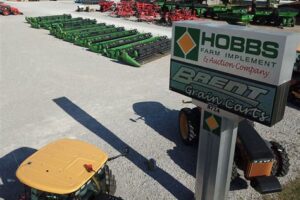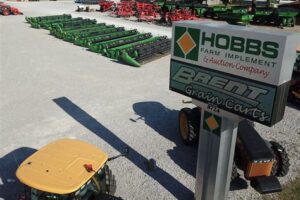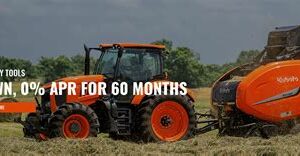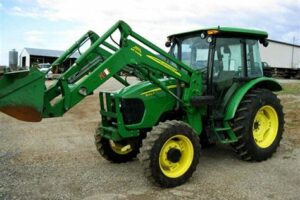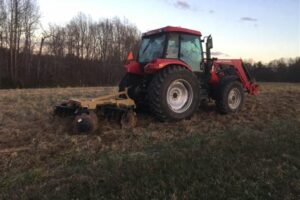Table of Contents
Farm Equipment Depreciable Life refers to the period of time over which farms depreciate or deduct the cost of their equipment for tax purposes. It is an important factor in financial planning for farmers, as it determines the annual depreciation expense and the overall value of the farm’s assets. Understanding the depreciable life of farm equipment helps farmers make informed decisions about purchasing, repairing, or replacing machinery to optimize their financial resources.
Farm equipment plays a crucial role in the agricultural industry, allowing farmers to efficiently carry out their daily tasks and maximize productivity. However, just like any other asset, farm equipment has a limited lifespan, and its value gradually diminishes over time due to wear and tear. Understanding the depreciable life of farm equipment is essential for farmers and agricultural businesses as it directly impacts their financial planning and decision-making processes. In this article, we will delve into the concept of depreciable life for farm equipment, exploring its significance and factors that influence it. So, let’s delve into the world of farm equipment depreciation and unravel the secrets behind its economic lifespan.
Farm Equipment Depreciable Life
Farm equipment is a crucial asset for farmers as it helps them perform various tasks efficiently and effectively. However, like any other machinery or equipment, farm equipment depreciates over time due to wear and tear, technological advancements, and changes in market value. Understanding the depreciable life of farm equipment is essential for farmers to make informed decisions about their investments and financial planning. In this article, we will explore the concept of depreciable life for farm equipment and its significance in the agricultural industry.
What is Depreciable Life?
Depreciable life refers to the estimated period over which an asset, such as farm equipment, is expected to be used by a business or individual before it becomes obsolete or needs replacement. It represents the useful life of the equipment, during which it retains its value and generates income for the farmer. The depreciable life is determined based on various factors, including the type of equipment, its condition, technological advancements, and industry standards.
Factors Affecting Depreciable Life of Farm Equipment
Several factors influence the depreciable life of farm equipment:
- Type of Equipment: Different types of farm equipment have varying depreciable lives. For example, tractors may have a longer depreciable life compared to specialized harvesting equipment.
- Usage Intensity: The frequency and intensity of equipment usage can impact its depreciable life. Equipment used extensively may wear out faster than equipment used sparingly.
- Quality and Maintenance: Well-maintained equipment tends to have a longer depreciable life. Regular servicing, repairs, and adherence to maintenance schedules can extend the equipment’s useful life.
- Technological Advancements: As technology evolves, newer and more advanced equipment may replace existing models. Technological obsolescence can significantly reduce the depreciable life of farm equipment.
- Market Demand and Value: Changes in market demand and value for specific types of farm equipment can also impact their depreciable life. If a particular piece of equipment becomes less sought after, its depreciable life may be shortened.
Calculating Depreciation of Farm Equipment
Depreciation is the decrease in an asset’s value over time. It is calculated by subtracting the salvage value (the estimated residual value of the equipment at the end of its useful life) from the original cost of the equipment and dividing it by the depreciable life. The resulting value represents the annual depreciation expense.
Importance of Understanding Depreciable Life
Understanding the depreciable life of farm equipment is crucial for farmers for several reasons:
- Financial Planning: Knowledge of depreciable life helps farmers plan their finances effectively, allowing them to set aside funds for future equipment replacement or upgrades.
- Budgeting: By knowing the depreciable life, farmers can allocate appropriate funds towards equipment maintenance and repairs, ensuring smooth operations.
- Equipment Replacement: Understanding depreciable life enables farmers to assess when it is financially viable to replace aging equipment with newer models that offer improved efficiency and productivity.
- Resale Value: Being aware of the depreciable life helps farmers determine the optimal time to sell or trade their equipment, maximizing its resale value.
Depreciable Life and Tax Implications
Depreciable life also has significant tax implications for farmers. In many countries, including the United States, farmers can claim depreciation expenses as tax deductions. The depreciable life determines the duration over which these deductions can be claimed. It is essential for farmers to consult tax professionals or accountants to ensure proper compliance with tax regulations and maximize tax benefits related to farm equipment depreciation.
Regular Equipment Evaluation
To accurately determine the depreciable life of farm equipment, it is necessary for farmers to regularly evaluate their machinery and equipment. This evaluation should consider factors such as maintenance records, technological advancements, market demand, and overall condition. By conducting regular equipment assessments, farmers can make informed decisions regarding repairs, replacements, and upgrades, ensuring the longevity and profitability of their farming operations.
Conclusion
Farm equipment depreciates over time due to various factors, and understanding its depreciable life is crucial for farmers. By considering factors such as equipment type, usage intensity, quality and maintenance, technological advancements, and market demand, farmers can estimate the depreciable life of their equipment. This knowledge allows them to plan their finances, budget effectively, assess equipment replacement, maximize resale value, and optimize tax benefits. Regular equipment evaluation ensures accurate assessment of depreciable life, enabling farmers to make informed decisions about their agricultural investments and operations.
Introduction to Depreciable Life of Farm Equipment
The depreciable life of farm equipment refers to the duration over which the equipment is expected to depreciate in value. This is an important factor to consider for farmers when budgeting for equipment purchases and determining the overall cost of ownership. Depreciable life can vary depending on the type of equipment, usage, maintenance, and technological advancements.
Determining Factors for Depreciable Life
Several factors influence the depreciable life of farm equipment. The quality and durability of the equipment, frequency of use, operating conditions, and proper maintenance can all impact how quickly the equipment’s value depreciates. Technological changes and advancements in the industry may also shorten the depreciable life as newer and more efficient equipment becomes available.
Quality and Durability
The quality and durability of farm equipment are crucial factors in determining its depreciable life. Equipment made from high-quality materials and designed with robust construction methods will generally have a longer lifespan and slower depreciation. Investing in well-built equipment from reputable manufacturers can result in higher resale value and reduced replacement costs in the long run.
Frequency of Use
The amount of time farm equipment spends in operation directly affects its depreciable life. Heavy and continuous use can accelerate wear and tear, leading to faster depreciation. Conversely, equipment used seasonally or intermittently may have a longer depreciable life. Farmers need to carefully evaluate their equipment usage patterns to estimate the anticipated depreciable life and plan for replacement or upgrades accordingly.
Operating Conditions
The operating conditions under which farm equipment is used can significantly impact its depreciable life. Equipment exposed to harsh weather conditions, rough terrain, or corrosive substances may experience accelerated deterioration and depreciation. Implementing proper storage, maintenance, and protection measures can help mitigate these effects and extend the equipment’s lifespan.
Proper Maintenance
Proper maintenance plays a crucial role in extending the depreciable life of farm equipment. Regular cleaning, lubrication, and timely repairs can help prevent wear and tear, reducing depreciation and prolonging the useful life of the equipment. Following manufacturer guidelines for maintenance and servicing is essential to ensure optimal performance and maximize the equipment’s lifespan.
Technological Advancements and Depreciable Life
The rapid pace of technological advancements in the agricultural industry can significantly affect the depreciable life of farm equipment. As newer, more efficient models are introduced with enhanced features and capabilities, older equipment may become obsolete faster, resulting in shorter depreciable lives. Farmers need to consider technological advancements when evaluating the best time to replace or upgrade their equipment to ensure optimal operational efficiency.
Financial Implications of Depreciable Life
The depreciable life of farm equipment has financial implications for farmers. A shorter depreciable life means that the equipment’s value will depreciate faster, leading to higher capital expenditures for replacement or upgrades. On the other hand, a longer depreciable life can spread out the equipment’s cost over more years, resulting in lower annual depreciation expenses and potentially improved profitability.
Depreciable Life and Resale Value
Understanding the depreciable life of farm equipment is crucial when considering its future resale value. Equipment with a longer depreciable life may retain higher resale value as it is considered more reliable and has a longer useful life remaining. On the other hand, equipment with a shorter depreciable life may have a lower resale value, making it important to plan for replacement or trade-in accordingly.
Factors Influencing Depreciable Life in Different Equipment Types
Different types of farm equipment may have varying depreciable lives depending on their nature and specific characteristics. For example, tractors may have a longer depreciable life compared to specialized equipment like balers or combines due to their versatility and broader range of applications. Understanding the specific factors influencing depreciable life for different equipment types is essential for effective equipment management and financial planning.
In the agriculture industry, farm equipment is an essential component for modern-day farming operations. These machines are not only expensive investments but also crucial assets that contribute to the efficiency and productivity of the farm. However, just like any other piece of machinery, farm equipment has a limited lifespan and depreciates over time. Determining the depreciable life of farm equipment is of utmost importance for farmers and agricultural businesses to accurately assess their financial standing and make informed decisions.
Here are some key points of view regarding the depreciable life of farm equipment:
- Depreciation as a financial tool: Depreciation allows farmers to allocate the cost of their farm equipment over its useful life, providing a more accurate representation of the equipment’s value on their balance sheet. By recognizing the depreciation expense, farmers can better plan their finances, manage cash flow, and make educated decisions about equipment replacement or upgrading. It also helps in determining the fair market value for insurance purposes or when selling or trading equipment.
- Factors influencing depreciable life: The depreciable life of farm equipment depends on various factors, including the type of equipment, frequency of use, maintenance practices, technological advancements, and changes in farming practices. For example, tractors and combines may have a longer depreciable life compared to specialized equipment used for specific tasks. Additionally, advancements in technology may render certain equipment obsolete or less efficient, leading to shorter depreciable lives.
- Consideration of wear and tear: Farm equipment is subject to significant wear and tear due to the nature of agricultural operations. Factors such as exposure to harsh weather conditions, heavy usage during peak seasons, and challenging terrain can affect the condition and performance of the equipment. Therefore, the depreciable life should take into account these factors and the expected deterioration of the equipment over time.
- Proper maintenance and care: Regular maintenance and proper care can extend the depreciable life of farm equipment. Farmers should follow manufacturer guidelines for maintenance, schedule routine inspections, and promptly address any repairs or issues. By implementing good maintenance practices, farmers can not only maximize the lifespan of their equipment but also potentially increase its resale value.
- Technology advancements: Technological advancements in the agricultural industry are constantly introducing new and improved farm equipment. These advancements may result in shorter depreciable lives for older machinery as farmers seek to upgrade to more efficient, precise, and environmentally friendly equipment. Staying abreast of technological developments is crucial for farmers to remain competitive and optimize their operations.
In conclusion, determining the depreciable life of farm equipment is essential for farmers and agricultural businesses to accurately assess the value, financial impact, and replacement needs of their machinery. Considering factors such as depreciation as a financial tool, wear and tear, maintenance practices, and technological advancements ensures a comprehensive understanding of the equipment’s lifespan and aids in making informed decisions for sustainable and efficient farming operations.
Thank you for visiting our blog and taking the time to learn more about the depreciable life of farm equipment. We hope that this article has provided you with valuable insights into the lifespan of these essential tools in agriculture. As professionals in the field, it is crucial to understand the depreciation of farm equipment as it directly impacts the financial planning and decision-making processes of farmers and agricultural businesses.
Understanding the depreciable life of farm equipment is vital for both farmers and those involved in the agricultural industry. Farm equipment plays a significant role in modern farming practices, improving efficiency, productivity, and overall yields. However, like any other asset, farm equipment depreciates over time due to wear and tear, technological advancements, and changes in market demand. By knowing the average depreciable life of different types of farm equipment, farmers can make informed decisions when it comes to purchasing, selling, or leasing machinery.
The depreciable life of farm equipment can vary depending on several factors. The type of equipment, its usage, maintenance, and technological advancements are some of the key determinants of how long it will remain productive and economically viable. For example, tractors, combines, and harvesters generally have a longer depreciable life compared to smaller equipment like tillage tools or spraying machines. However, advancements in technology can render older equipment less efficient and cost-effective, leading to shorter depreciable lives.
It is essential for farmers to consider the depreciable life of their equipment when making financial decisions. Understanding how long a piece of machinery will last allows farmers to plan for future expenses, such as repairs, replacements, or upgrades. Additionally, knowing the depreciable life helps farmers determine the optimal time to sell or trade-in their equipment to maximize its value. By staying informed about the depreciable life of farm equipment, farmers can make strategic choices that not only contribute to their productivity but also ensure the financial stability and success of their operations.
We hope that this article has shed light on the depreciable life of farm equipment and its importance in the agricultural industry. As professionals in the field, it is essential to stay updated on these trends and educate ourselves about the economic aspects of farming. By understanding the depreciable life of farm equipment, we can make informed decisions that positively impact our operations and contribute to the overall growth and sustainability of the agricultural sector.
Thank you once again for visiting our blog, and we encourage you to explore more of our articles to expand your knowledge on various topics related to farming and agriculture. Should you have any further questions or require additional information, please do not hesitate to reach out to us. Happy farming!
Video Farm Equipment Depreciable Life
People also ask about Farm Equipment Depreciable Life:
-
What is the depreciable life of farm equipment?
The depreciable life of farm equipment refers to the period over which the equipment’s value can be deducted for tax purposes. The specific depreciable life of farm equipment can vary depending on the type of equipment and its intended use.
-
How long do tractors last on average?
The average lifespan of a tractor depends on various factors, including the brand, model, maintenance, and usage. Generally, well-maintained tractors can last anywhere from 20 to 30 years or even longer.
-
What is the typical depreciation rate for farm equipment?
The depreciation rate for farm equipment can vary based on the specific type of equipment. However, the Internal Revenue Service (IRS) provides guidelines for depreciation rates. For example, the IRS assigns a seven-year recovery period for most farm machinery and equipment, meaning it can be depreciated over a seven-year period for tax purposes.
-
Can farm equipment be fully depreciated?
Under certain circumstances, farm equipment can be fully depreciated in a single year using Section 179 of the Internal Revenue Code. This provision allows businesses, including farms, to deduct the full cost of qualifying equipment purchased or leased during the tax year, up to a certain limit.
-
What happens when farm equipment is fully depreciated?
When farm equipment is fully depreciated, it means that the equipment’s value has been completely deducted for tax purposes. Once fully depreciated, the equipment no longer has any remaining tax basis and cannot be further depreciated in subsequent years.
Professional voice and tone:
The depreciable life of farm equipment can vary depending on its type and intended use. Tractors, for instance, tend to last around 20 to 30 years with proper maintenance. The Internal Revenue Service provides guidelines for depreciation rates, assigning a seven-year recovery period for most farm machinery and equipment. However, under Section 179 of the Internal Revenue Code, farm equipment may qualify for full depreciation in a single year. Once fully depreciated, the equipment can no longer be further depreciated for tax purposes.

